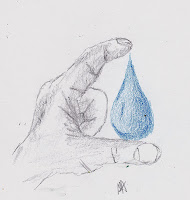It is hard to imagine that climate change and innovation
have something to do with each other. However, new research into archaeological innovation and climate change indicates that there are important similarities
in history between changes in the environment, cultural interaction, and an
explosion in societal innovation. Africa
was once a hot bed of human adaptation and change and sets a historical example
that modern innovators may find useful.
Africa around 60,000 to 80,000 years ago began to experience
higher environmental changes forcing humans to adapt their practices. Martin
Ziegler, an earth scientist from Cardiff University in Wales, believes that
early humans adapted when parts of Sub-Sahara Africa experienced conditions
that were more hospitable for humans.
As the global temperature shifted cooler, based upon ocean
activity, the world found that some areas were more lush while others more dry.
In the study environmental activity was compared against archeological findings
to determine changes in innovative behavior. Habitable environmental changes
produced higher levels of innovation during specific beneficial climatic adjustments.
As populations became denser they interbreed and changed their
cultural perceptions. In Africa, people began to interact more closely with
other tribes and learn from each other. It is through this population explosion
and interaction that new ways of viewing the world were developed that
eventually transformed culture.
The researchers found better jewelry, tools, hunting
techniques, and artistic designs associated with this population explosion.
Studies have found that once the innovations took place they disappeared a short
time later. The scientists further believe that climate may have something to
do with this innovation and then stagnation of human development.
As the environment became more habitable birth rates had a
corresponding increase. As tribal members swelled their ranks, they were forced
to interact with each other in new trading partnerships. There simply was less
land mass separating groups. Yet once the climate and habitat changed and the
populations separated innovation declined with it.
Previous research on innovation helps shed light on the
concept that increased interactivity of human thoughts creates new ways of
thinking about such issues. Innovation in society is based upon a small subset
of society that develops new products and a larger group of followers that
adopt such innovations once they have been developed.
Once these adaptations were integrated into a tribal society
they are spread to other tribes through interaction and trading. In essence,
the same activity of connecting useful information that occurs in our heads
also occurs within the physical environment when people use these thoughts to
combine old tools into new tools. Each innovation is a thought about how to use
products in new ways. The more we associate and connect them the more
innovative we become.
With climate change becoming more important to people today and the Internet spreading information at lightning speed those
societies that can adapt new technologies fastest are likely to reap the
most awards from innovation. The same process of information sharing, trade, and interaction is
important today in the virtual world as it was so many years ago in Sub-Sahara
Africa. Many of the same processes are still at play even if the modality is different.
The development of modernity in early human populations has
been linked to pulsed phases of technological and behavioural innovation within
the Middle Stone Age of South Africa. However, the trigger for these
intermittent pulses of technological innovation is an enigma. Here we show
that, contrary to some previous studies, the occurrence of innovation was
tightly linked to abrupt climate change. Major innovational pulses occurred at
times when South African climate changed rapidly towards more humid conditions,
while northern sub-Saharan Africa experienced widespread droughts, as the
Northern Hemisphere entered phases of extreme cooling. These millennial-scale
teleconnections resulted from the bipolar seesaw behaviour of the Atlantic
Ocean related to changes in the ocean circulation. These conditions led to
humid pulses in South Africa and potentially to the creation of favourable
environmental conditions. This strongly implies that innovational pulses of
early modern human behaviour were climatically influenced and linked to the
adoption of refugia.
Ziegler, et. al. (2013). Development of middle stone age
innovation linked to rapid climate change. Nature
Communications, 4 (1905). Retrieved May 21, 2013 from http://www.nature.com/ncomms/journal/v4/n5/full/ncomms2897.html
Further Reading:
